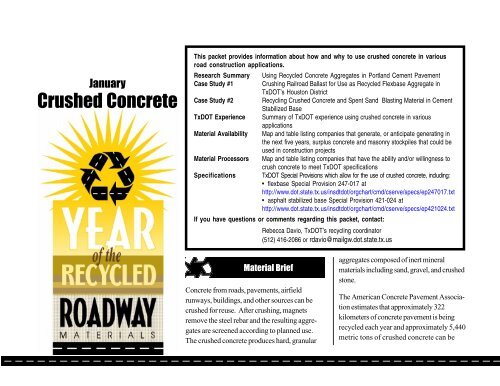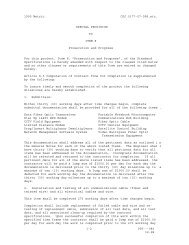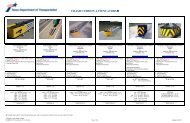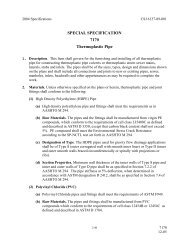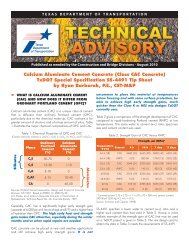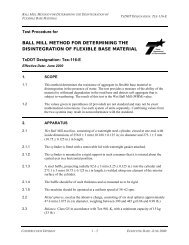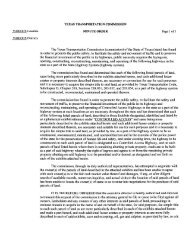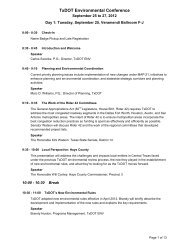Crushed Concrete - FTP Directory Listing
Crushed Concrete - FTP Directory Listing
Crushed Concrete - FTP Directory Listing
Create successful ePaper yourself
Turn your PDF publications into a flip-book with our unique Google optimized e-Paper software.
January<br />
<strong>Crushed</strong> <strong>Concrete</strong><br />
This packet provides information about how and why to use crushed concrete in various<br />
road construction applications.<br />
Research Summary Using Recycled <strong>Concrete</strong> Aggregates in Portland Cement Pavement<br />
Case Study #1 Crushing Railroad Ballast for Use as Recycled Flexbase Aggregate in<br />
TxDOT’s Houston District<br />
Case Study #2 Recycling <strong>Crushed</strong> <strong>Concrete</strong> and Spent Sand Blasting Material in Cement<br />
Stabilized Base<br />
TxDOT Experience Summary of TxDOT experience using crushed concrete in various<br />
applications<br />
Material Availability Map and table listing companies that generate, or anticipate generating in<br />
the next five years, surplus concrete and masonry stockpiles that could be<br />
used in construction projects<br />
Material Processors Map and table listing companies that have the ability and/or willingness to<br />
crush concrete to meet TxDOT specifications<br />
Specifications TxDOT Special Provisions which allow for the use of crushed concrete, including:<br />
flexbase Special Provision 247-017 at<br />
http://www.dot.state.tx.us/insdtdot/orgchart/cmd/cserve/specs/ep247017.txt<br />
asphalt stabilized base Special Provision 421-024 at<br />
http://www.dot.state.tx.us/insdtdot/orgchart/cmd/cserve/specs/ep421024.txt<br />
If you have questions or comments regarding this packet, contact:<br />
Rebecca Davio, TxDOT’s recycling coordinator<br />
(512) 416-2086 or rdavio@mailgw.dot.state.tx.us<br />
Material Brief<br />
<strong>Concrete</strong> from roads, pavements, airfield<br />
runways, buildings, and other sources can be<br />
crushed for reuse. After crushing, magnets<br />
remove the steel rebar and the resulting aggregates<br />
are screened according to planned use.<br />
The crushed concrete produces hard, granular<br />
aggregates composed of inert mineral<br />
materials including sand, gravel, and crushed<br />
stone.<br />
The American <strong>Concrete</strong> Pavement Association<br />
estimates that approximately 322<br />
kilometers of concrete pavement is being<br />
recycled each year and approximately 5,440<br />
metric tons of crushed concrete can be
eclaimed from 1.6 km of concrete pavement<br />
with an average thickness. This shows that<br />
2.6 million metric tons of reclaimed concrete<br />
is being recycled annually in the United<br />
States.<br />
TxDOT has specifications that allow crushed<br />
concrete to be used in flexbase, cementstabilized<br />
base, and riprap. Additionally,<br />
crushed concrete can be used as coarse<br />
aggregates in Portland Cement <strong>Concrete</strong> and<br />
as fine aggregates in asphalt stabilized base.<br />
Overview<br />
Recycling of Portland cement started in<br />
Europe after World War II. With time and<br />
through necessity, recycled aggregates have<br />
become increasingly acceptable as road<br />
construction. It is estimated that approximately<br />
100 million tons of concrete rubble is<br />
generated annually in the United States. This<br />
amount is projected to exceed 150 million by<br />
the year 2000. Landfill life will be unnecessarily<br />
shortened if this volume of rubble is<br />
dumped there; furthermore, a valuable<br />
material will be wasted if not recycled into<br />
usable aggregate products.<br />
In comparison with the national annual<br />
aggregate production of more that 2 billion<br />
tons, concrete rubble represents only 5<br />
percent of the aggregate market if it is all<br />
recycled. Since some rubble is lost during<br />
demolition and some will be disposed of in<br />
landfills, recycled concrete aggregate is<br />
probably less than 3 percent of the total<br />
aggregate market. <strong>Crushed</strong> concrete, nonethe-less,<br />
represents significant opportunities<br />
for economic and environmental benefits.<br />
The Center for Transportation Research<br />
(CTR) of the University of Texas at Austin<br />
conducted a study on recycled materials for<br />
TxDOT. According to its findings, Pharr<br />
district had the biggest stockpile (3,624<br />
metric tons) of old concrete. Nine of the<br />
twenty-one TxDOT districts responded to<br />
the survey already had stockpiles of crushed<br />
concrete and nineteen districts believed that<br />
old concrete could be used as road-base<br />
material. TxDOT engineers from Abilene,<br />
Atlanta, Beaumont and Dallas districts rated<br />
the performance of concrete as excellent.<br />
2
Research Summary<br />
Recycled <strong>Concrete</strong> Aggregates<br />
in Portland Cement <strong>Concrete</strong><br />
Pavement<br />
Problem Statement<br />
Recycling of old concrete pavement has<br />
become an important issue as more concrete<br />
pavement reaches the end of its functional<br />
and structural life. Currently, economic<br />
considerations are the primary thrust for the<br />
use of recycled concrete aggregate (RCA) in<br />
portland cement concrete (PCC) pavement.<br />
However, as landfill spaces become more<br />
scarce and expensive, environmental considerations<br />
will play an important role as well.<br />
The section of IH 10 in Houston District<br />
between Loop 610 and IH 45 is under<br />
reconstruction. The contractor decided to<br />
use 100 % of RCA in the new pavement<br />
concrete. This project is the first one in the<br />
nation where all the aggregates used for<br />
pavement concrete, both coarse and fine, are<br />
recycled with no virgin aggregates used. As<br />
such, there is not much information available<br />
regarding the performance of PCC pavement<br />
with 100 % RCA.<br />
Objectives<br />
Objectives of this study were to (1) evaluate<br />
the engineering properties of recycled<br />
concrete aggregate (RCA) and portland<br />
cement concrete (PCC) made with that<br />
aggregate, (2) investigate the effect of RCA<br />
and PCC properties on continuous reinforced<br />
concrete pavement (CRCP) performance,<br />
and (3) develop guidelines for the<br />
effective use of RCA for CRCP.<br />
There are a number of factors affecting<br />
CRCP performance. They include adequacy<br />
of the pavement structure, material properties,<br />
environmental conditions during concrete<br />
placement, and construction practices.<br />
The scope of this study was limited to<br />
laboratory evaluation of RCA and PCC<br />
material properties, performance evaluation<br />
of CRCP sections in the Houston District,<br />
and analysis of information to develop<br />
guidelines for the use of RCA in CRCP.<br />
Findings - Performance<br />
The following conclusions are made base on<br />
the investigation of the effect of RCA and<br />
PCC properties on CRCP performance.<br />
Specific findings include:<br />
• The CRCP sections utilizing 100 %<br />
recycled coarse and fine aggregates have<br />
performed well. No distresses, including<br />
spalling, wide cracks, punchouts, or<br />
meandering cracks, have taken place. The<br />
transverse crack spacing distributions are<br />
comparable to those in concrete with<br />
natural siliceous river gravel.<br />
• The large amount of old mortar in recycled<br />
coarse aggregate does not appear to have<br />
an adverse effect on CRCP performance.<br />
• Moisture control of recycled aggregate is<br />
critical in producing consistent and workable<br />
concrete.<br />
• No significant adjustment in paving operations<br />
is necessary due to the use of 100 %<br />
recycled coarse and fine aggregate in<br />
concrete.
Finding regarding the engineering properties<br />
of recycled concrete aggregates and PCC<br />
made with them include:<br />
• The properties of recycled aggregates<br />
measured in this study are consistent with<br />
those reported elsewhere – lower specific<br />
gravity, higher water absorption, and higher<br />
sulfate soundness loss and LA abrasion<br />
loss – compared with those of virgin<br />
aggregates.<br />
• Recycled aggregates do not have a pronounced<br />
effect on compressive strength.<br />
• Recycled fine aggregates have an adverse<br />
effect on flexural strength.<br />
• The use of both recycled coarse and fine<br />
aggregates reduces modulus elasticity<br />
significantly.<br />
• For the same water/cement ration, replacing<br />
virgin sand with recycled sand does not<br />
result in changes in tensile strength.<br />
• Thermal coefficient of concrete containing<br />
100 % recycled aggregate is much higher<br />
than that of virgin aggregate concrete.<br />
• Recycled coarse aggregate has a much<br />
higher thermal coefficient than virgin<br />
aggregate due to the attached old mortar.<br />
• Sodium sulfate causes more damage to<br />
recycled coarse aggregate than magnesium<br />
sulfate, which is opposite virgin aggregate.<br />
• The effect of recycled aggregate on the<br />
abrasion resistance of concrete is inconclusive.<br />
• The validity of sulfate soundness and LA<br />
abrasion tests as tools for evaluating the<br />
quality of recycled aggregate needs to be<br />
investigates.<br />
The use of RCA in concrete has positive<br />
(larger creep, low modulus) and negative<br />
(Low strength, higher thermal coefficient)<br />
effects on CRCP performance. The combined<br />
effects can only be evaluated by actual<br />
long-term performance of CRCP in the field.<br />
Findings - Constructability<br />
In the beginning of the project, there was a<br />
problem producing concrete with consistent<br />
workability that met the minimum strength<br />
requirement. The primary reason for inconsistent<br />
workability was due to the lack of<br />
moisture control of recycled aggregate. A<br />
better sprinkler system was installed later for<br />
aggregate stockpiles, and moisture of the<br />
recycled aggregate was better controlled.<br />
This system mitigated the inconsistent workability<br />
problem. Paving operations were<br />
closely monitored to identify any variations<br />
that might result from using the recycled<br />
aggregate. Not much difference was observed.<br />
Construction crews were interviewed for<br />
their opinion and experience with the handling<br />
PCC containing RCA. One of the most<br />
often heard comments was that the concrete<br />
was not consistent. The next most frequent<br />
comment was that concrete sometimes set<br />
too quickly. This quick-setting problem is<br />
believed to be caused by recycled fine the<br />
mixing. Construction crews stated that when<br />
the concrete was of good workability, the<br />
finishing operation was not much different<br />
from normal concrete paving.
Implementation<br />
Even though it is too early to make any firm<br />
conclusions concerning the long-term effects<br />
of 100 % RCA on pavement performance,<br />
the good performance so far indicates RCA<br />
might be used for pavement concrete without<br />
compromising pavement performance.<br />
Guidelines for the effective use of RCA for<br />
CRCP are under development. Once<br />
complete, the document will provide information<br />
on how to recycle crushed concrete<br />
for pavement concrete and what needs to be<br />
done to maximize its potential benefits.<br />
The contents of this summary are<br />
reported in detail in TxDOT Research<br />
Report, 1753-1F, Use of <strong>Crushed</strong><br />
<strong>Concrete</strong> as Aggregate for Pavement<br />
<strong>Concrete</strong>, by Moon C. Won.<br />
This aggregate not being saturated<br />
during summary does not reflect the<br />
official views of TxDOT nor FHWA. To<br />
obtain a copy of this report, contact<br />
the TxDOT Research Librarian at<br />
(512) 465-7644.
Case Study #1<br />
Crushing Railroad Ballast for use<br />
as Recycled Flexbase Aggregates<br />
in TxDOT’s Houston District<br />
Abstract<br />
The Houston construction market boasts<br />
one of the highest recycling rates in Texas,<br />
especially when it comes to recycled<br />
aggregates. The distance to native aggregates<br />
resources (over 200 miles), high rate<br />
of construction, and rapid property redevelopment<br />
have stimulated the recycled<br />
aggregate markets to a level where they<br />
now supply an estimated 2.5 to 3 million<br />
tons of recycled products for construction<br />
annually, or as much as 1 / 4 of the total<br />
Houston area market. The sources for<br />
these products include highway, bridge and<br />
building demolition , and other sources<br />
including railroad right-of-way realignment.<br />
This case study looks specifically at one<br />
such railroad right-of-way salvage effort,<br />
and the almost $3.6 Million savings to<br />
TxDOT by recycling valuable aggregates<br />
instead of disposal in landfills. The project<br />
was conducted along a former railroad<br />
right-of-way adjacent to the north side of<br />
IH-10 in Houston, Texas. Information<br />
regarding the location and type of materials,<br />
as well as economic aspects of the<br />
project, are located in this summary.<br />
Note: In this case study TxDOT is both the<br />
generator of the material and the potential<br />
end user, enjoying savings in both aspects<br />
of the operation. The economics are still<br />
favorable when the crushed concrete is<br />
favorable when the crushed concrete is<br />
purchased from a third party.<br />
Project Overview<br />
In recent years, TxDOT has explored the<br />
use of recycled materials in its road construction<br />
and maintenance projects. A<br />
series of research efforts conducted by the<br />
state’s engineering universities determined<br />
that many alternative materials promised a<br />
variety of engineering, economic and<br />
environmental benefits. Much of this<br />
research has been completed with positive<br />
findings and results. At the Federal level,<br />
large quantities of similar materials have<br />
historically been used as highway construc-<br />
tion materials, with at least 34 states<br />
reporting some usage. This preponderance<br />
of evidence convinced the Houston<br />
District, when abandoning nearly 20 miles<br />
of railroad right-of-way, to seek a way to<br />
recycle the approximately 125,430 cubic<br />
yards of ballast and sub-ballast available.<br />
Economic Analysis<br />
Disposal in landfills near the right-of-way<br />
has historically been the most common<br />
method of managing this type of material.<br />
However, recycling was a very attractive<br />
option given the scarcity of local aggregates<br />
and the well-defined local gathering<br />
and distribution network for recycled<br />
materials. In addition to the high quality<br />
of the material (native rock ballast and<br />
sub-ballast), the economics of recycling<br />
over disposal were a clear vote for the<br />
reuse scenario. Approximately 125,430<br />
cubic yards of the ballast material was<br />
made available by TxDOT in a competitive<br />
sealed bid.
Economic Analysis<br />
Disposal Costs Avoided<br />
Disposal costs $1.5 Million<br />
Excavation and Transportation Landfill $1.4 Million<br />
Subtotal $2.9 Million<br />
Economic Benefit from Recycled<br />
Material Usage<br />
Approximate Recycled Material Production 200,000 tons<br />
Cost of Competing Native Materials $ 11.90/ton<br />
Cost of Recycled Materials 8.90/ton<br />
Subtotal (Economic Benefit) $0.4 Million<br />
Direct Revenue for Sale of Material<br />
Subtotal $0.29 Million<br />
Total Economic Benefit for TxDOT $3.59 Million<br />
Material Information<br />
Railway company specifications for subballast<br />
material match well with TxDOT<br />
specification for flexible base. Main railway<br />
ballast, however, requires intermediate<br />
processing to meet the flex base specification.<br />
The chemical and physical characteristics of<br />
the recycled aggregate generated from this<br />
railroad right-of-way salvage effort were<br />
similar to those of typical native materials,<br />
foreign debris aside. Processing involved<br />
removal of foreign debris, and primary and<br />
secondary crushing and screening to<br />
achieve the correct gradation. To avoid<br />
inadvertent particle size segregation, fine<br />
aggregates and coarse aggregates are<br />
sometimes separately stockpiled. The<br />
finished product is expected to have very<br />
favorable mechanical properties for aggregate<br />
usage.<br />
Results and Conclusion<br />
The recycled aggregate met design and<br />
construction specifications as a substitute<br />
ingredient in the production of the recycled<br />
flexible base. Potential uses for the material<br />
include flexible and cement stabilized<br />
base, engineered fill, and other uses such<br />
as an aggregate in flowable fill or perhaps<br />
in hot mix asphalt concrete.<br />
Economic advantages to the Department<br />
included a net economic benefit of approximately<br />
$3.59 million over traditional<br />
transportation and disposal alternatives.
Case Study #2<br />
Recycled <strong>Crushed</strong> <strong>Concrete</strong> and<br />
Spent Sand Blasting Material in<br />
Cement Stabilized Base<br />
Test Data on <strong>Crushed</strong> <strong>Concrete</strong>—Houston District<br />
Highway/County C-S-J Date<br />
Sampled<br />
A case study is being prepared by Texas<br />
Tech University summarizing a test project<br />
constructed in the Houston District using<br />
crushed concrete and spent sand blasting<br />
material in cement stabilized base. This<br />
project is located on SH6 just south of US<br />
290 West. The TxDOT control number for<br />
LL PI D a<br />
(lb./cu.ft.)<br />
OMC<br />
(%)<br />
SH 249/Harris 720-3-73 1/10/96 122.1 10.5<br />
I-45/Harris 7/2/94 18.9 1.7 123.9 9.6<br />
IH 45/Harris 110-5-77 10/25/95 32 3 119.8 10.3 1-3/4" --- 0<br />
No. 4 --- 53<br />
No. 40 --- 67<br />
SH 6/Harris 1685-05-057 6/10/97 22 2 123.8 9.3<br />
SH 249/Harris 0720-03-081 5/1/96 30 7 124.5 9.8 1-3/4" --- 0<br />
No. 4 --- 62<br />
No. 40 --- 77<br />
LL = Liquid Limit<br />
PI = Plasticity Index<br />
D a = Density<br />
OMC = Optimal Moisture Content<br />
Gradation<br />
(Cumulative Percent retained)<br />
this project is 1685-05-057. The case study<br />
should be completed in the fall and will be<br />
available on TxDOT’s web site:<br />
www.dot.state.tx.us<br />
Preliminary results for tests on selected<br />
crushed concrete bases used in the Houston<br />
District are provided in the table below.
Excerpts from Houston District specifications<br />
for crushed concrete in cement stabilized base<br />
indicate that “When salvaged existing base and<br />
asphaltic concrete pavement are used, the<br />
material shall be sized so that all the material,<br />
except the existing individual aggregate, shall<br />
pass the 2-inch sieve and be of a gradation to<br />
allow satisfactory compaction. The material is<br />
to be salvaged in a manner which will not<br />
introduce deleterious material (clay, organics,<br />
etc.). Material passing the No. 40 sieve<br />
(defined as soil binder) shall have a plasticity<br />
index not to exceed ten, and a liquid limit not<br />
to exceed 35 when tested in accordance with<br />
test method Tex-106-E.” Additionally, the<br />
Houston District allows “With permission of<br />
the engineer, sand may be blended in the mix.”
<strong>Crushed</strong> <strong>Concrete</strong><br />
This table provides information about TxDOT’s experience using crushed concrete in several different construction applications<br />
including: embankment and backfill, asphaltic concrete paving, base and subbase, and Portland Cement <strong>Concrete</strong>. The district,<br />
location, results, date installed, specifications used and additional comments are also provided.<br />
District<br />
Name<br />
Construction<br />
Application<br />
Beaumont Embankments &<br />
Backfill<br />
Corpus<br />
Christi<br />
TxDOT Experience<br />
Embankments &<br />
Backfill<br />
Lufkin Embankments &<br />
Backfill<br />
Bryan Paving Materials -<br />
Asphaltic <strong>Concrete</strong><br />
Pharr Paving Materials -<br />
Asphaltic <strong>Concrete</strong><br />
Atlanta Paving Materials -<br />
Base / Subbase<br />
Austin Paving Materials -<br />
Base / Subbase<br />
Beaumont Paving Materials -<br />
Base / Subbase<br />
Fort Worth Paving Materials -<br />
Base / Subbase<br />
Results Installed Specification Location Additional Comments<br />
Good 1994 None SH 82, SH 87 Used for embankment to control erosion on<br />
Intercoastal Waterway.<br />
Excellent 1977 132 Various Embankments. Also, outfall erosion protection.<br />
Excellent 1982 District wide<br />
Good 1986 340-003-99 US 290 W<br />
Good 1993 Specs.<br />
(3834)<br />
Good 1991 Standard Panola, Bowie (US 79,<br />
FM 123, US 259)<br />
Good 1987 No Travis & Hays County<br />
US 281 S. of Pharr Only used once in Type "A" hot mix.<br />
Good 274 SPUR 380 Cement stabilized base<br />
Good 1991 81 88 (3-91) Tarrant County MSE Wall Backfill
Houston Paving Materials -<br />
Base / Subbase<br />
Paris Paving Materials -<br />
Base / Subbase<br />
Amarillo Paving Materials -<br />
Portland Cement<br />
Childress Paving Materials -<br />
Portland Cement<br />
Houston Paving Materials -<br />
Portland Cement<br />
Good 1987 Item 276 District wide Slightly lower compressive strength than crushed<br />
limestone but adequate for our requirements.<br />
Good 1989 Unknown I-30 - Hopkins Co. Material used to create a drainable subbase for new<br />
PCC.<br />
Good 1996 360 IH 40 Used in place of a percent of cement.<br />
Unknown 1996 247 Hall (US 287)<br />
Good 1996 Item 360<br />
(S.P. 421)<br />
IH-10 Pavement is being monitored.<br />
If a TxDOT project using crushed concrete was omitted from this list, please use the form available on TxDOT’s web site<br />
(www.dot.state.tx.us) or call (512) 416-2562.
Material Processors<br />
This table, and the map following, provide information on companies that have expressed an ability and/or willingness to crush concrete<br />
to meet TxDOT specifications.<br />
Name City State ZIP TxDOT district Phone <strong>Concrete</strong> Mobile processing<br />
Allied Paving Company El Paso TX 79904 El Paso (915) 755-7625 A / W TRUE<br />
Amarillo Road Co. - Rock Crusher Amarillo TX Amarillo (806) 335-2922 A / W TRUE<br />
American Materials Inc Missouri City TX 77459 Houston (281) 449-1506 A / W TRUE<br />
Arbuckle Materials Edmond OK 73083 (405) 340-6026 W TRUE<br />
Archer-Western Contractor Arlington TX 76006 Fort Worth (817) 640-3898 A / W TRUE<br />
Ballanger Construction Co. San Benito TX 78586 Pharr (956) 399-5381 A / W FALSE<br />
Bay LTD. Corpus Christi TX 78469 Corpus Christi (512) 289-7995 A / W TRUE<br />
Beck Pit Mission TX 78573 Pharr (956) 581-2751 W TRUE<br />
Big City <strong>Crushed</strong> <strong>Concrete</strong> Dallas TX 75229 Dallas (972) 243-5820 A / W TRUE<br />
Bowie Bridge LLC New Boston TX 75570 Atlanta (903) 628-6670 W FALSE<br />
Cherokee Bridge & Road Inc. Junction TX 76849 San Angelo (915) 446-3710 A / W TRUE<br />
Clemons Trucking Dallas TX 75241 Dallas (972) 224-1130 W TRUE<br />
Colorado Materials Co. Inc New Braunfels TX 78132 San Antonio (512) 396-1555 A / W FALSE<br />
Dolese Bros. Co - Recycle Plant Oklahoma City OK 73101 NA (405) 235-2311 A / W TRUE<br />
Durwood Greene Construction Co. Angleton TX 77515 Houston (409) 848-3040 A / W TRUE<br />
E.D. Baker Corporation Borger TX 79007 Amarillo (806) 273-7501 A / W TRUE<br />
Foremost Paving Inc Weslaco TX 78596 Pharr (956) 968-5471 A / W TRUE<br />
Franklin Industrial Minerals Nolanville TX 76559 Waco (254) 698-2511 A / W FALSE<br />
Fuller & Sons Amarillo TX 79108 Amarillo (806) 373-6049 A / W TRUE<br />
Garrett Construction Ingleside TX 78362 Corpus Christi (512) 776-7575 A TRUE<br />
Gifford-Hill & Co - Ferris Plant Ferris TX 75125 Dallas (972) 225-7328 W FALSE<br />
Gifford-Hill & Co. - Bridgeport Plant Bridgeport TX 76426 Fort Worth (940) 683-4294 W FALSE
Gifford-Hill & Co. - Cobb Plant Seagoville TX 75159 Dallas (972) 287-4500 W FALSE<br />
Gifford-Hill & Co. - Waco Plant Waco TX 76705 Waco (254) 752-4385 W FALSE<br />
Gilvin-Terrill Inc - Crusher Amarillo TX 79105 Amarillo (806) 944-5200 A / W TRUE<br />
H&B Contractors Inc McGregor TX 76657 Waco (254) 848-4461 W FALSE<br />
H.V. Caver Inc Atlanta TX 75551 Atlanta (903) 796-8253 W FALSE<br />
Holms Construction Amarillo TX 79121 Amarillo (806) 356-8294 A / W TRUE<br />
Ingram ReadyMix Inc. New Braunfels TX 78132 San Antonio (830) 625-9156 W FALSE<br />
J.H. Strain & Sons Inc. #1 Crusher Tye TX 79563 Abilene (915) 668-1227 A / W TRUE<br />
James Cape & Sons Co. Racine WI 53401 (414) 639-2552 A / W TRUE<br />
Jobe <strong>Concrete</strong> Products Inc El Paso TX 79930 El Paso (915) 565-4681 A / W TRUE<br />
Jones Brothers Odessa TX 79760 Odessa (915) 332-0721 A / W TRUE<br />
L.A. Fuller & Sons Construction Inc Amarillo TX 79107 Amarillo (806) 373-6049 A / W TRUE<br />
Lewis Construction Co. - Dumas Dumas TX 79029 Amarillo (806) 935-5641 A / W TRUE<br />
Leyendecker Materials Laredo TX 78041 Laredo (956) 722-5126 A / W FALSE<br />
M. Hanna Construction Company Ennis TX Dallas (903) 885-6772 W TRUE<br />
Marock Inc. Dallas TX 75229 Dallas (972) 869-2971 A / W FALSE<br />
Mathews Construction Company Jasper TX 75951 Beaumont (409) 384-4520 W FALSE<br />
Mendez Construction Company Corpus Christi TX 78469 Corpus Christi (512) 265-9500 W TRUE<br />
Meridian Aggregates Powderly TX 75473 Paris (903) 732-3124 W TRUE<br />
Pavers Supply Co. - Conroe Plant Conroe TX 77303 Houston (409) 756-6960 A / W TRUE<br />
Rebcon Inc Dallas TX 75220 Dallas (972) 444-8230 W FALSE<br />
Recycled Stone Co. - Huntsville Plant Huntsville TX 77340 Bryan (409) 756-6960 A / W TRUE<br />
Russell & Sons Construction Co. Longview TX 75602 Tyler (903) 758-5578 A TRUE<br />
Sanco Materials Co. Robert Lee TX 76945 San Angelo (915) 944-9693 A FALSE<br />
South Texas Aggregates Knippa TX 78870 San Antonio (830) 934-2614 A / W TRUE<br />
Southern <strong>Crushed</strong> <strong>Concrete</strong> - Chrisman Houston TX 77039 Houston (281) 987-8789 A / W TRUE<br />
Southern <strong>Crushed</strong> <strong>Concrete</strong> - Gasmer Houston TX 77035 Houston (281) 987-8789 A / W TRUE<br />
Southern <strong>Crushed</strong> <strong>Concrete</strong> - Griggs Houston TX 77021 Houston (281) 987-8789 A / W TRUE<br />
Southern <strong>Crushed</strong> <strong>Concrete</strong> - Tanner Road Houston TX 77041 Houston (281) 987-8789 A / W TRUE<br />
Southern <strong>Crushed</strong> <strong>Concrete</strong> - Wilcrest Houston TX 77072 Houston (281) 987-8789 A / W TRUE
Stringtown Materials L.P. Stringtown OK 74569 (580) 346-7376 W FALSE<br />
Sundt Construction Austin TX 78719 Austin (512) 891-5834 A / W FALSE<br />
Texas Industries (TXI) Tomball TX 77375 Houston (281) 357-3565 A / W TRUE<br />
Vega Sand and Gravel Inc. Vega TX 79092 Amarillo (806) 267-2147 A / W TRUE<br />
Vulcan Materials Co. - 1604 Quarry San Antonio TX 78247 San Antonio (210) 695-8547 A FALSE<br />
Williams Brothers - Airtex Crusher Houston TX 77073 Houston (713) 522-9821 A / W TRUE<br />
Williams Brothers - Bennington Crusher Houston TX 77022 Houston (713) 522-9821 A / W TRUE<br />
Zack Burkett Co. - Perry Pit Graham TX 76450 Wichita Falls (940) 549-6732 A / W TRUE<br />
Zack Burkett Co. - Richards Pit Jacksboro TX 76458 Fort Worth (940) 549-6732 A / W TRUE<br />
The information provided in this table is based on submission by the companies list. TxDOT does not represent that any of such information<br />
is necessarily accurate or correct. Likewise, TxDOT does not intend, nor should anyone conclude, that companies listed are<br />
endorsed in any way, for any purpose, by TxDOT.<br />
Any person or firm not listed, who believes that person or firm qualifies to be so listed, is invited to submit the required information.<br />
Please contact Andy Andrasi at (512) 416-2562, for more information.
Specifications<br />
The following TxDOT Special Provisions allow for the use of crushed concrete in flexbase and asphalt<br />
stabilized base.<br />
• Flexbase Special Provision 247-017<br />
http://www.dot.state.tx.us/insdtdot/orgchart/cmd/cserve/specs/ep247017.txt<br />
Asphalt Stabilized Base Special Provision 421-024<br />
http://www.dot.state.tx.us/insdtdot/orgchart/cmd/cserve/specs/ep421024.txt


